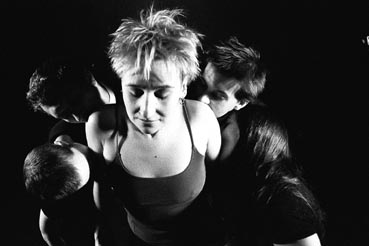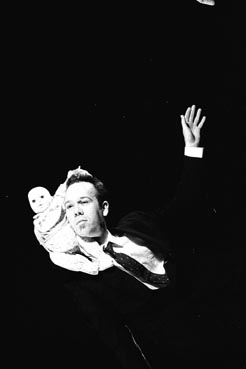Dance Review: Open Water, a Voyage to Remember
Lightsey Darst reviews the Dylan Skybrook Company's "Open Water" at the Red Eye Theater. Shows are February 28-29 and March 4-5.


We begin as children. A man tries to re-enact his childhood; he carries
himself tenderly, throws himself away, then cradles himself in his arms.
We deny our childhood; dressed in suits, men and women pose as stable adults,
when in reality they’re seasick from the motion of their lives, apt to slip or crumble. Our parents occupy our eyes long after they’ve left the stage; we copy their fights and embraces, and carry their angers with us for years.
From them we learn how to move. We remain children, still craving satisfaction and searching each other for it; we clutch at falling images of the past. Sometimes we reach an understanding, not free of the past but able
to shift it, carry it, dance with it; naturals, we swim in the open water.
This is the emotional ground of Dylan Skybrook Company’s latest
performance, and it’s a fertile zone. The performance doesn’t change how we
think about childhood and families, but it opens the subject–a subject that gets
less time on stage than romantic love and adult relationships. This performance shows that modern dance is an ideal instrument for exploring the family drama.
Skybrook is
especially good at shifting focus: a woman shakes in her anxiety, alone on
stage, with the audience allowed inside her mind; then a father shows a son
how to move, and it’s a scene we might spy on from across the street; one
dancer comes forward and narrates, while the others enact Hollywood-sized
romances we see through her eyes. The performance consists of
ten or so separate dances, each arising from a different situation.
Acting, rather than dancing, carries the theme. Skybrook has collected six
good actors (especially Sarah Gordon, with her commanding, generous
presence); but considering that they’re even better dancers, it’s a shame
they can’t dance their parts throughout. The speeches aren’t worth the cheat
of having dancers tell you what they are dancing about. The least defined
scenes, in which Skybrook trusts gesture and movement, work best: a woman
(Sarah Gordon) teeters, trying to smooth her belly away, and the motion
ripples outward and ends without resolution; businessmen and women try to
maintain equilibrium, but parts of their bodies spasm, give them away. It’s
not clear what the father is teaching the son (Greg Waletski and Jesse
Walker)– “how to fight, how to speak, how to ‘be a man’ “–only that the son
wants to learn, to please his father. Dance doesn’t deal in specifics, but
in states, moods, being; dance is most successful and moving when it
explores common experience through new forms.
The choreography sometimes feels lacking, as if a dimension’s lost. This missing
dimension shifts–dancers don’t move between the front and back of the stage;
dancers move in straight lines rather than arcs; the choreography is
oriented to the front of the house; dancers don’t touch; the dancers aren’t
pushed to their limits. Skybrook can close each of these gaps, but he rarely
closes them all at once. When he does, the movement fascinates, hooks us the
same way a good pop song does. In fact, the performance is set to pop music
(White Stripes, Nirvana), and Skybrook’s choreography embodies the music: he
hits beats and floats refrains in a shameless and utterly satisfying way that’s rare in modern dance.
Is it time to talk about Megan Flood? Or has everyone already done that?
Her torso is a noble horse’s neck, bending, arching, cut from wind. Her
jumps and balances go beyond hangtime: she’s a cat, nearly but not quite still in the air, and then she lands. There’s a suspension that’s not suspension, an afterimage, as if her body were lit. Go and see her leap; you‚ll be addicted.
Sarah Gordon is also impressive here. Her feet, legs, and hips make pure and strong lines; she bends the air of the stage around
her body. Watching these dancers, and the other members of the company, I’m
reminded of what dance can do: you’re filled, you don’t know how, with an
emotion that doesn’t have a name, that arises from the body, original, uncut
by words.
Despite its flaws, this is an intensely satisfying performance. The final
dance telegraphs its breakthrough, its new peace, by having the dancers
change to all-white, drifty linen costumes (the work of Sarah Gordon) and
pass around café glasses full of freshly Brita-filtered water, but I’m
willing to go along with the manipulation. With the engaging theme, shifting
stories, the use of music, and excellent dancing, Skybrook sends his
audience away smiling. Perhaps his next work will show a deeper interaction
between theme and movement; it will certainly be worth seeing.